|
Stories in Stone
|

|
CHAPTER VIII
TERTIARY LANDSCAPES
THE Cenozoic, the last of the geologic eras, includes two periods of geologic time—the Tertiary period (the age of mammals) and the Quaternary period (the age of man).
Many years ago the groups of sedimentary rocks were named in order from oldest to youngest—Primary, Secondary, Tertiary, and Quaternary. The last two names have survived, but the first two are no longer used as names of geologic periods.
The rocks of Tertiary age in America are chiefly of upland or non-marine origin and contain relatively few fossils, but Tertiary sediments that accumulated in sea water near the ancient margin of the continent contain great numbers of fossils. In fact, at some places the Tertiary rocks consist almost wholly of shells. A slab of rock containing such shells led to an incident which, although it occurred several years ago, still remains fixed in my memory.
Language of the Rocks
I was looking at material in the fossil room of the National Museum when a man and a boy entered and leisurely began to examine the curiosities.
They stopped before a slab of rock like that pictured in Plate XLVI, which contained many fossil shells, some of them standing out plainly, others deeply imbedded in the rock.
"Dad! What are these things?" inquired the boy, pointing to the fossils.
"Words," replied the man, "Those are all words."
I looked up in surprise, prepared to correct the statement. But I did not correct it. Something in the expression of the man kept me from interfering.
The boy seemed to be less surprised than I was. To him the museum was a house of wonders. Everything was strange. Nothing was beyond belief. He had not yet developed the "critical mind of wisdom." Instead of showing surprise he innocently asked, "Is this another Egyptian tablet like the one we saw in the other room?"
"Something like that," replied the man, "except that this language is much older than the Egyptian." "Do you remember," he asked, drawing a piece of paper from his pocket on which were some curious characters, "what these words are?"
"Yes," replied the boy, interested at once. And then the lesson in Egyptology was rehearsed.
"Very good! Now, the words of this other language are not more difficult than the Egyptian." "This word," continued the man, pointing to a coiled shell, "is gastropod. The one near it is pelecypod. For the present you may say snail and clam. Some day you may learn that these words tell a story about animals that lived long ago."
"That must be a strange language," ventured the boy, with a questioning glance to see if his father was really in earnest.
"Yes, to many it is a strange language, but to those who know it, its meaning is very clear.
"It is the language of creation. This slab of rock is a page from the story of the ancient inhabitants of the earth. The fossil-words may seem strange to you now, but later you will learn that the language may be translated and that it tells many a fascinating story."
The boy seemed skeptical, and the father, accepting his challenge to read this particular story, said:
"Notice first that this is a thin layer of rock, split away from other layers that once lay above and below it. They were piled up, one above another, like the leaves in a story book. This leaf tells among other things that the part of the story of the earth which it contains is near the end, just as page 200 in a book tells you that its part of the story is near the end.
"This slab of fossils comes from high up in the pile of leaves. The fossil words tell that it is from the part of the story which is called Tertiary and from the chapter known as Miocene. The fossils say that about the middle of the time known to geologists as the Tertiary period shallow sea water covered the part of Virginia where this rock was found. In the water of this sea lived many snails and clams. Their shells were buried in the mud, and in time this mud hardened to rock.
"Long afterward the sea bottom was raised out of the water and became land. The rain and the streams wore away the softer parts of the rock, leaving the harder parts standing as hills and bluffs."
"Dad," inquired the lad, who was naturally more interested in the fossils than he was in the story, which he could only half understand, "are many of the rocks covered with fossils like this one?"
"No! Few of them are so plainly marked. But there are many places in river bluffs where specimens just as good might be found."
"Say, Dad!" exclaimed the boy with enthusiasm, "Let's go after some of our own. I want to spring this on Bob and Skinny. I'll bet they never heard a story like this."
Then I received another mild shock, for, instead of rebuking the boy for harboring an unworthy motive, his father promised to show him where he could find the shells and to help him in framing a story for his boy friends.
Here was the university professor of the future receiving his early training. For what is a teacher except one who delights in telling the "Bobs" and the "Skinnies" and all other comers about things that interest him?
Bryce Canyon
The Tertiary rocks, like those of each of the older systems, are represented in a national park, or what will some day be a national park. Bryce Canyon (Plate XXX) was made a national monument by presidential proclamation in 1923, and during the following year Congress provided that it shall become a national park when all the land within its borders shall be the property of the Government.
Bryce Canyon is a bowl-shaped cavity that is eroded to a depth of nearly 1,000 feet into one of the high plateaus of Utah. The bowl is about three miles long and two miles wide and is open at one end. The brilliantly colored Tertiary rocks in which it is formed are eroded into a wilderness of pinnacles and spires and monuments, all carved in a profusion of ornamental designs. Some are graceful, others are grotesque; some are beautiful and impressive, others are bizarre. But all are intensely fascinating.
Bryce Canyon contains an astonishing array of startling beauty and grotesque grandeur. Those who enjoy flights of fancy can see here castles and cathedrals, Greek temples and Chinese pagodas, mosques and minarets and monuments in endless, bewildering variety. Those who would look beneath the superficial form may discover here an impressive exhibition of one of the processes by which highlands are torn down and carried to the sea. The sedimentary rocks that were built up layer on layer throughout the long ages of early Tertiary time are now being reduced to fragments and washed into Colorado River for transportation to the sea.
In geologic history, as in human history, a system built up laboriously in one age is torn down in a succeeding age and replaced by another system.
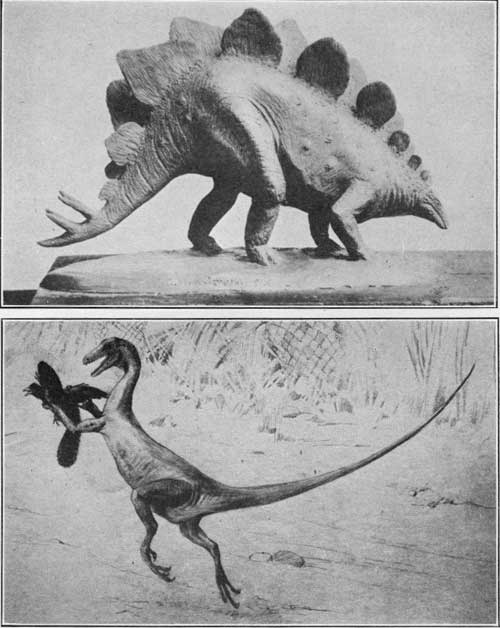
|
|
PLATE XXVIII, A
(top). "BEHOLD THE MIGHTY DINOSAUR, FAMOUS IN PREHISTORIC
LORE."
A restoration by C. W. Gilmore of the U. S. National Museum of an armored reptile (Stegosaurus) of Mesozoic time, whose remains are found in the Morrison formation. PLATE XXVIII, B
(bottom). RESTORATION OF A BIRD-CATCHING DINOSAUR (ORNITHOLESTES)
REPRESENTED IN THE ACT OF CAPTURING ONE OF THE PRIMITIVE BIRDS CALLED
ARCHAEOPTERYX.
By permission of the American Museum of Natural History. |
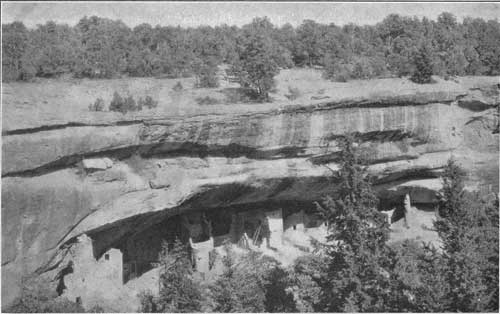
|
|
PLATE XXIX.
SPRUCE-TREE HOUSE, AN ANCIENT CLIFF DWELLING IN MESA VERDE NATIONAL
PARK, COLORADO.
Mesa Verde hides in its barren canyons the well-preserved ruins of a civilization that passed out of existence long ago. Photograph by Herbert W. Gleason. By courtesy of National Park Service. |
In general it may be said that the Tertiary period was ushered in by a world-wide revolution. Seas changed places and mountains arose where sea water had been. Whole races of animals were obliterated and new races took their places. Whole floras or groups of plants disappeared and new floras appeared.
It was this revolution that eventually ended the dominance of reptiles and introduced mammals as the rulers of the earth. The reptiles did not at once disappear, nor did the mammals at once spring into prominence. Indeed, the reptiles have not yet disappeared, nor have the mammals yet developed beyond the possibility of improvement. Nevertheless the Tertiary is known as the age of mammals.
At the beginning of the Tertiary period great geographic changes occurred in western America. The sea that had covered the central part of the continent was expelled at the end of Cretaceous time. Mountains arose in its place and plateaus were lifted out of the sea. However, some parts of the West remained low, and on them gathered the sand and clay derived from the newly formed highlands.
The marine life of the region was destroyed. The great "sea serpents"—the mosasaurs—disappeared, as did also the peculiar toothed birds and flying dragons. But some of the forms of land life persisted with relatively little change. Some dinosaurs remained, but not the particular species that had lived in Cretaceous time. The plants, too, underwent a change. The unrecorded interval of time between the two periods, although short in a geologic sense, was long enough to permit the removal by erosion of many thousands of feet of rock from the newly made mountains.
An Age of Violence
The geologist thinks of the Tertiary period as one of tumultuous earth action. Earthquakes were then doubtless violent, and volcanic eruptions were numerous. Apparently the slow-moving dinosaurs found life too strenuous for endurance, for they disappeared forever soon after the beginning of the Tertiary period. Several explanations have been offered for their extinction. Some have held that the bulky creatures were not able to endure the earthquake shocks. Others have maintained that their disappearance was due to the prevalence of volcanic dust, which choked them. Still others believe that their eggs were eaten by the increasing swarms of diminutive mammals. The explanations thus offered are all somewhat fanciful, and there seems to be no more reason for seeking a special explanation of the disappearance of the dinosaurs than of that of the mammoth or of any other of the thousands of species of animals that flourished for a time and then became extinct.
In the plateau country the earth's activities were somewhat different from those in the Rocky Mountains. There were great crustal movements and a general rise of land. But this rise produced table-lands rather than mountain ranges.
However, several small groups of mountains were formed, in which molten rock seeking a way of escape from the interior failed to reach the surface, but became lodged between subsurface beds. These intrusions raised the rocks above them until they looked like huge blisters. Instead of pouring from some opening in the crust of the earth and spreading over the surface, the molten matter lifted the layers of rock near the surface into great domes, beneath which it gathered, cooled, and solidified. These once molten cores of the mountains are known to geologists as laccoliths. Erosion has removed the domed strata and exposed some of these laccoliths, but the upbowed sedimentary rocks in others, as in Navajo Mountain, in southern Utah, still conceal the igneous rocks which domed them.
Near the western edge of the plateau country sedimentary rocks ranging in geologic age from Cambrian to early Tertiary are found in full thickness. Originally these rocks extended beyond their present limit, but how much beyond no one can tell. They were eroded away after the upheaval in the early part of the Tertiary period. Over large areas sedimentary rocks thousands of feet thick were stripped from the underlying crystalline rocks. On the newly formed floor of ancient rocks were piled mountainous masses of lava. These early lavas formed light-colored varieties of igneous rock called andesite and rhyolite (Plate XXXI).
At some time during the Tertiary period the earth's crust in the plateau country was broken into huge blocks, and these blocks were lifted, tilted, and generally disturbed. Doubtless these disturbances extended over thousands of centuries. Doubtless also they were accompanied by violent earthquakes and volcanic eruptions, for in the canyon country there are volcanic rocks of many different epochs.
This elevation of the plateaus and the erosion following it produced much of the natural scenery for which western America is famous.
Tertiary Animals
The Tertiary period was a time of rapid change in the form and habits of living creatures as well as change in the physical aspects of the country. The reptiles that were dominant in the preceding age became subordinate in Tertiary time. Soon after the beginning of this period the great dinosaurs disappeared and mammals took their place as rulers of the earth.
Among the reptiles of early Tertiary time were three peculiar forms—the great carnivorous dinosaur, Tyrannosaurus—a name expressive of his ferocious appearance; Triceratops, the three-horned dinosaur; and Anchylosaurus, an armored creature that has been called an animated fortress.
In the first of these monsters, known as Tyrannosaurus rex (Plate XXXII, A), the king of tyrant lizards, the flesh eaters reached their apex, for rex was 47 feet long and stood nearly 20 feet high. His head was 4 feet 3 inches long and his powerful jaws were armed with teeth 3 to 6 inches long and an inch thick. The sharp claws that terminated his enormous toes were 6 to 8 inches long and were curved like the talons of an eagle. The forearms were so small as to indicate that rex must have walked entirely on his powerful hind legs. A nearly perfect skull of this creature is exhibited in the American Museum of Natural History, in New York City. It is with a feeling of awe that the observer stands before this huge head and contemplates a beast of such terrible ferocity.
Rex had several contemporaries that were scarcely less formidable than himself. One called Albertosaurus, which lived in Canada, is said to have rivaled rex in both size and ferocious appearance. Against the weapons of such adversaries as Tyrannosaurus and Albertosaurus the enormous horns of Triceratops and the heavy protective armor of Anchylosaurus seem to have been necessary for mere existence.
An Animated Fortress
Anchylosaurus was a beaked dinosaur related to the older armored dinosaur Stegosaurus, which had flourished in the same region several millions of years earlier. Like his ancient ancestor, Anchylosaurus was a vegetable eater of peaceful nature, without fighting tusks or aggressive armament of any kind. He was a contemporary of the tyrant lizards and therefore needed protective covering. His entire back was covered with flat bony plates. He was low in stature, had a short, blunt head, and carried on the end of his thick, heavy tail a large triangular bony club. His eye was protected by a cup-like bony shutter, like the visor of a helmet, which he could close over the eyeball.
All the vulnerable parts of this animated fortress were protected by bony armor. The legs were short, massive, and straight, ending probably in elephant-like feet. The "horned toad," one of the small modern lizards of the western plains, is not very different in external appearance from the armored dinosaur except in size.
Another modern armored lizard, the moloch, found in Australia, resembles Anchylosaurus in repulsive ugliness and in the possession of elaborate protective armor.
Like the modern banded armadillo, Anchylosaurus maintained a secure existence behind his protective covering. He has been called the most ponderous animated citadel the world has ever seen, and he evidently presented a defensive exterior that was proof against the attacks of his contemporary, the tyrant king, who did not exterminate the race. Some of the bones of these animals of demoniacal appearance have been found in the Hell Creek beds of Montana; others have been found in rocks of about the same age in Alberta. They evidently roamed over a large part of the western interior of North America.
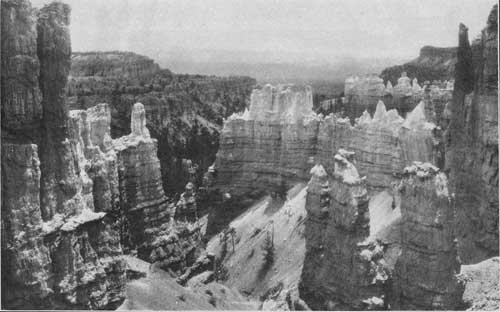
|
|
PLATE XXX. PINNACLES
AND SPIRES IN BRYCE CANYON, UTAH.
The rocks are highly colored and are carved into monuments that show astonishing variety of form. Courtesy Union Pacific System. |
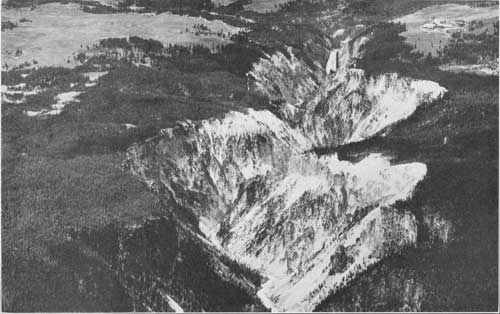
|
|
PLATE XXXI. CANYON
OF YELLOWSTONE RIVER AS SEEN FROM AN AIRPLANE; LOOKING
UPSTREAM.
The canyon is eroded to a depth of more than 1,000 feet in volcanic rock of Tertiary age. Official photograph U. S. Army Air Service. |
Fall of Reptilian Imperialism
Here we may profitably note that the most perfectly armed and most powerfully equipped natural fighters that the world has ever known lived side by side with the most perfectly armored and the most completely protected creatures that imagination can picture. Perhaps those who are today advocating the disarmament of nations have read the lesson that geology teaches so plainly and are trying to apply nature's remedy, for Tyrannosaurus, the militant king, and Anchylosaurus, the animated fortress, were "scrapped" and fossilized together.
It may further be pointed out that these most powerful fighters and most perfectly armored beings were the last of their race. Reptilian nature had done its best—or worst—in both offensive and defensive armament, and as if recognizing the futility of further endeavor these reptiles perished from the face of the earth.
Bones of the dinosaur Triceratops (three-horned-face), so named in allusion to the three horns on the head (Plate XXXII, B), are found also in rocks of early Tertiary age. Over each eye was a long, massive horn, directed forward and terminating in a sharp point, and the nose usually bore a third but smaller horn. A mounted skeleton of a Triceratops in the National Museum at Washington, D. C., is about 20 feet long and stands 8 feet high at the hips. Some skulls measure more than 8 feet, over a third the length of the animal. This great length of head is due largely to the remarkable bony frill, which projects backward over the neck like a fireman's helmet.
That Triceratops, although a plant eater, was a fighter and often engaged in combat appears to be shown by its broken and healed bones. A dinosaur horn in the National Museum bears witness to such an encounter. It was broken during the life of the animal and healed to a rounded stump. Although Triceratops had an enormous head it had a smaller brain in proportion to its size than the least intelligent land animal of the present time. Fossil impressions of the skin show that it was covered with hexagonal scales.
As the dinosaurs retired from the stage of action creatures of higher intelligence and more supple movement, capable of adapting themselves to the rapidly changing physical conditions of Tertiary time, took their places.
Physical Records
The fossil remains of great numbers of these early mammals have been collected in museums and their significance has been pointed out. But although fossils are excellent records of geologic events they are not the only records. The attitude of the sedimentary rocks—whether upturned or flat-lying—the canyons, the peaks, and the plains all tell their story.
Two general types of sedimentary beds of Tertiary age occur in North America—those near the borders of the continent, formed wholly or partly in the sea, and those in the interior of the continent, consisting of rock débris deposited chiefly by streams. The Rocky Mountains of Colorado and other ranges farther west, which began to rise at the beginning of the Tertiary period and continued to rise intermittently during that period, furnished this material. The streams that drained these newly made mountains carried the material to the lower lands and spread it out in broad sheets.
On the plains, near the meandering streams, lived a great variety of mammals. The ever-changing physical conditions of the region, brought about by the repeated rise of the mountains, the volcanic disturbances, and the shifting of the streams, forced changes in the habits of these animals. Those that could adapt themselves to the new conditions survived; those that could not do so perished.
The Tertiary was a period of physical change and of rapid evolution of life. It was the schooling time during which animal life reached the high degree of perfection that culminated in man. It is evident that the improvement in the race of animals was effected through struggle with a constantly varying succession of difficulties. The relative tranquillity that prevailed during most of the Cretaceous period was followed by great changes.
Activity was the order in Tertiary time. Nature was busy reconstructing continents, building mountains, and generally changing the complexion of the face of the earth. The inhabitants of the earth had to adapt themselves to the changing conditions or perish. The old order was replaced by the new. The revolution that introduced the Tertiary period was the "world war" of geology. The following period, during which all things became new, was a time of reconstruction, of advancement and rapid evolution, a time when the life of the world was greatly improved.
The Tertiary period has been subdivided into four epochs. These epochs, named in order from oldest to youngest, are the Eocene, Oligocene, Miocene, and Pliocene. The Eocene epoch was very long, and by many geologists it is subdivided into Eocene proper and an older epoch called Paleocene. The Paleocene saw the extinction of the dinosaurs and the rise of the primitive mammals. The Eocene proper saw the great development of the larger mammals.
Some of the Eocene mammals had a generalized structure—that is, they possessed capability of development along different lines. One of the early mammals, for example, was an ancestor of flesh-eating creatures through one line of descent and of herb-eaters through another line. Many of these first mammals were curious looking creatures, such as Eobasileus, the Loxolophodon referred to in the verses quoted beyond. This great giant had a curiously shaped, long head with two pairs of bony protuberances resembling horns, one pair at the posterior end of the skull and one midway. A smaller single protuberance adorned the nose, and a pair of great tusks extended downward from the upper jaw.
Ancient Mammals
The skull of Eobasileus and the skulls of some of his associates seem to indicate clearly why many of the prehistoric monsters did not survive. These extinct giants, although as large as elephants, had brains that were ridiculously small. Their intelligence seems to have been inferior even to that of the modern rhinoceros. Judging from their small brain capacity it would seem that these early Tertiary monsters scarcely knew enough to take care of themselves. They perished. There were no asylums in Tertiary time for the weak minded.
One of the enemies of Eobasileus was the creodont, a wolf-like creature, one of the first flesh-eating mammals.
But other kinds of Tertiary mammals were able to meet the requirements of their age. Very early in the age of mammals there lived a group of creatures called the Condylarthra. These were probably the ancestors of such modern hoofed animals as the horse, the tapir, and the rhinoceros. They had five toes on each foot and each toe was tipped with a small hoof, such as is seen on each toe of some modern animals; others had claws.
These beings gave rise to several races, and each race followed its own particular line of development. One race retained all five hoofed toes on each foot; another lost all but two and developed into the split-hoofed animals, such as sheep and cattle; still another race lost all but one toe, thus producing the horse and other single-hoofed animals.
The First Horse
The earliest known direct ancestor of the horse yet found is Eohippus, a little creature about the size of a fox, which had four functional toes on each forefoot and three on each hind foot. Other toes were only vestiges or were wholly missing. But Eohippus had possibilities of development. Through growth and change and evolutionary development there appeared Orohippus, then Miohippus and Pliohippus, and finally Equus, the modern horse.
The Tertiary period was one during which broad, grassy upland plains were formed in western America. Doubtless then, as now, animals that lived in the open, without the protection of forests in which to conceal themselves, must have been able either to defend themselves when attacked or to flee from their enemies. The ancestral horse was not a fighter, but it had the capacity of developing speed, and the history of the horse through the geologic epochs, as well as through the period of human history, shows improvement in the mechanism that makes for swift movement and great endurance.
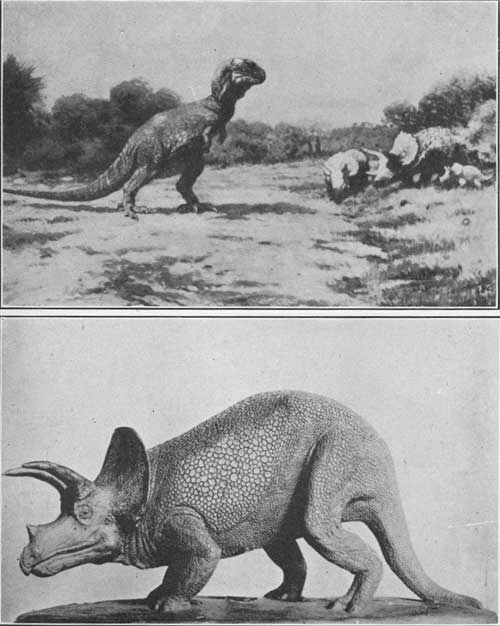
|
|
PLATE XXXII. A
(top). A TYRANT KING (TYRANNOSAURUS REX).
Restoration by Charles R. Knight of a huge carnivorous dinosaur of early Tertiary or Paleocene time. It was a formidable creature about 40 feet in length, with jaws 5 feet long, armed with long, sharp teeth adapted to tearing flesh. To the right is a group of reptiles (Triceratops) which were contemporaries of the tyrant king. By permission of the American Museum of Natural History. PLATE XXXII, B
(bottom). OLD THREE-HORN-FACE (TRICERATOPS).
A restoration of the last of the dinosaurs by C. W. Gilmore of the U. S. Natural Museum. The illustration shows the small horn on the nose, a large horn over each eye, the bony frill on the neck, and the armored hide. |
Apparently, as time went on, ancestral horses found increasing need for speed, and in striving for greater agility they rose more and more on to the ends of the toes, as the modern dancer rises for the same purpose. As evolution progressed the horse depended more and more on the middle toe, which was gradually developed at the expense of the side toes, and these in time became mere vestiges and at last disappeared, leaving only the middle toe.
Poetical Paleontology
The development of Eohippus into the modern horse was made the subject of the following verses by Charlotte Perkins Stetson.1
There was once a little animal
No bigger than a fox,
And on five toes he scampered
Over Tertiary rocks.
They called him Eohippus,
And they called him very small,
And they thought him of no value—
When they thought of him at all;
For the lumpish Dinoceras
And Coryphodon so slow
Were the heavy aristocracy
In days of long ago.
Said the little Eohippus,
"I am going to be a horse!
And on my middle finger-nails
To run my earthly course!
I'm going to have a flowing tail!
I'm going to have a mane!
I'm going to stand fourteen hands high
On the psychozoic plain!"
The Coryphodon was horrified,
The Dinoceras shocked;
And they chased young Eohippus
But he skipped away and mocked.
Then they laughed enormous laughter,
And they groaned enormous groans,
And they bade young Eohippus
Go view his father's bones.
They said "You always were as small
And mean as now we see,
And that's conclusive evidence
That you're always going to be.
What? Be a great, tall, handsome beast,
With hoofs to gallop on?
Why! You'd have to change your nature!"
Said the Loxolophodon.
They considered him disposed of,
And retired with gait serene;
That was the way they argued
In "the early Eocene."
1In This Our World, p. 95. Small, Maynard & Co., 1898.
These verses differ rather sharply from some attempts to incorporate scientific material in popular writing, for in them no distortion of fact lurks under poetic license. Dinoceras and Coryphodon (Plate XXXIV, A) were contemporaries of the ancestral horse, and the middle fingernail on these animals corresponds to the hoof of the horse. It may be noted that the argument of the small-brained Loxolophodon relative to possibilities of self-improvement has a strangely familiar sound.
Although rocks of later Tertiary age are not found in the canyon country, those rocks contain records that lead up to events that are an essential part of the story of the canyon country. At some places near the borders of the North American continent Tertiary sediments were being laid down in water to form records such as those illustrated in Plate XLVI, which shows a variety of fossil shells preserved in great perfection.
In the western interior of the continent sediments from the recently formed highlands were spread out over the broad upland plains and entombed the bones of innumerable animals, such as Titanotherium and Protoceros, the American rhinoceros, the four-horned deer, and several kinds of camels.
These were some of the ancient inhabitants of North America in Tertiary time before the high plateaus and their canyons came into being.
| <<< Previous | <<< Contents>>> | Next >>> |
stories_in_stone/chap8.htm
Last Updated: 31-Dec-2009